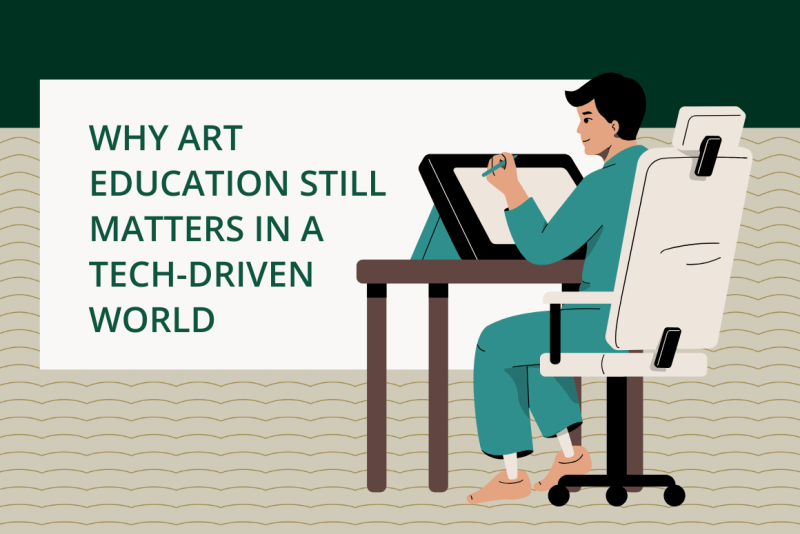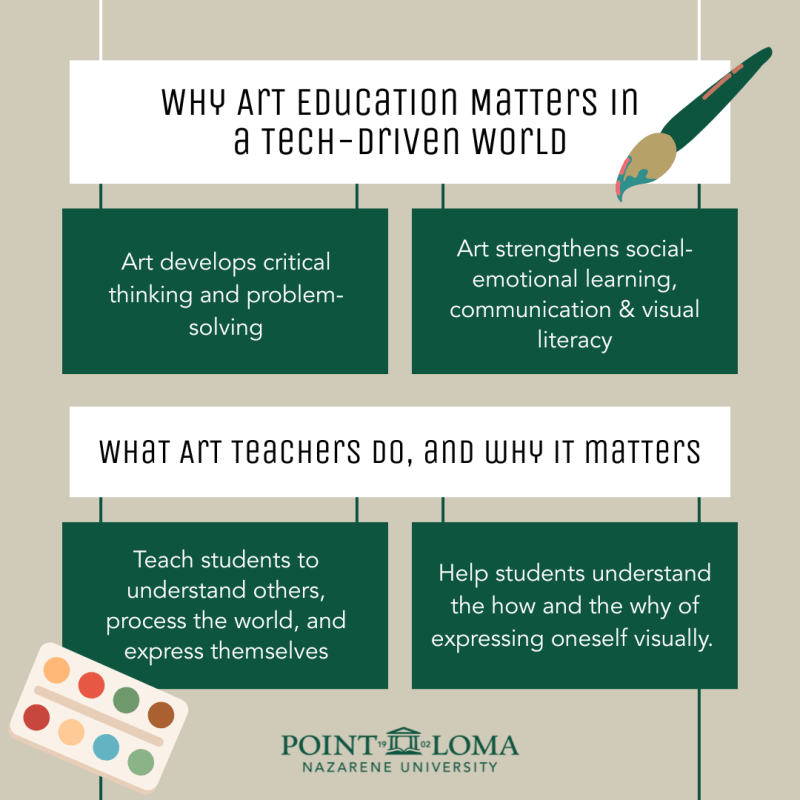
With the rise of schools prioritizing STEM (science, technology, engineering, and math) skills to meet market demands, it’s not crazy to ask, “Does art still matter in this tech-driven world?”.
With AI and automation on the rise, schools are doubling down on tech skills. Coding and data science skills are often considered safer bets for future job security than careers in the arts.
But even in a STEM-focused world, art education is essential — for developing creativity, empathy, and critical thinking.
Are you interested in a career path in the arts?
Do you question whether a creative field is a practical path in today’s tech-driven world?
If so, you’ve come to the right place. In this article, you’ll learn:
- Why art still belongs in schools
- How art helps students learn and grow
- What art teachers do and why it matters
- Jobs you can get with an art education degree
- How PLNU prepares future art teachers
Let’s first look at how art continues to play a vital role in education.
Why Art Still Belongs in Schools
Here are 3 reasons why art is important in school as a foundation for a balanced education.
1. Art develops critical thinking and problem-solving.
Creating art requires students to make decisions, experiment, and continually revise their work. These skills transfer directly to math, science, and writing.
2. Art strengthens social-emotional learning.
Art teaches students how to express emotions, build empathy, and process complex feelings. All of these are necessary for creating healthy relationships and emotional development.
3. Art improves communication and visual literacy.
Whether drawing, painting, or designing, students learn alternative ways to communicate and express themselves. Being able to express ideas and emotions visually is a key skill in today’s media-heavy world.
The biggest benefit of an art education is its ability to keep students engaged and motivated.
A study in Houston found that students involved in arts education saw a 13% improvement in writing scores — clear evidence of the value of art for students. Additional research shows that high schoolers who take art courses are more likely to graduate and pursue further education.
Knowing why art belongs in schools leads naturally to understanding how it helps students grow.
How Art Helps Students Learn and Grow
Beyond boosting academic performance, the value of art for students lies in how it nurtures a student's self-identity, resilience, and creativity in ways that traditional subjects often can’t.
A prime example of why art is important in school is that it helps students develop a strong sense of self.
Students gain confidence and self-awareness when exploring personal experiences and beliefs through creative expression. For students who struggle in test-driven subjects, this is especially meaningful.
Art helps students feel recognized and confident — especially those who struggle in traditional subjects.
Engaging in the arts also fosters independent thinking and innovation. Art education encourages students to:
- Take creative risks
- Trust their instincts
- Embrace ambiguity
Most of all, art in school teaches students how to explore complex problems with flexible thinking — all essential life skills in any career path.
Art also improves focus, patience, and emotional regulation. Sketching, painting, or sculpting teaches students to slow down, persevere through frustration, and refine their thoughts and ideas. These benefits are especially powerful for neurodiverse learners, for whom art offers an accessible and empowering outlet.

What Art Teachers Do and Why It Matters
Art teachers do more than hand out paint brushes, operate a kiln, or organize an art show. They plan thoughtful lessons combining technique with discovery. Art teachers help students understand the how and why of expressing oneself visually.
While teaching skills like color theory, perspective, and composition, they encourage students to take risks creatively and develop their unique artistic voice. A well-rounded art education provides students with projects connecting with history, culture, and current events. Art education is more than a subject — it’s a bridge connecting students to a much bigger world.
Great art teacher education produces more than skilled instructors. It produces mentors who shape lives through creativity.
Imagine what a school without art teachers would look like:
- Who would teach students how to express their emotions into something visual and meaningful?
- Who would create a safe place where making mistakes isn’t something to fear but a part of the process?
- Who would help students discover their unique voice when words alone aren’t enough?
Without art teachers, many students — especially those who struggle in traditional academic settings — might never discover their creative strengths or feel truly seen in the classroom.
Art teachers don’t just teach art—they teach students how to process the world, how to understand others, and how to express themselves when words fall short.
In a tech-driven world shaped by algorithms and standardization, art education offers one of the few spaces where individuality, imagination, and personal voice are not only welcomed but essential.
Great art education starts with passionate, well-trained teachers who guide and inspire.
But teaching isn’t the only career option with a degree in art education.
Jobs You Can Get With an Art Education Degree
Earning an art education degree opens the door to several creative and meaningful professions.
Many graduates pursue traditional jobs for art teachers, such as working in elementary, middle, or high schools. But art education goes beyond the walls of a classroom.
Creative and artistic paths include roles such as:
- Graphic Designers: Design logos, websites, and digital or print advertisements
- Illustrator: Develop visuals for books, magazines, websites, and social platforms
- Animator: Use animation techniques to bring characters and stories to life
- Fashion Designer: Create clothing, accessories, and branded merchandise
- Photographer: Capture images for use in advertising, digital media, and visual storytelling
In museums and galleries, careers include:
- Curator: Oversee the selection, acquisition, and care of artwork for exhibitions
- Art Dealer: Represents artists and advises collectors on acquiring valuable works
- Art Historian: Research, interpret, and write about the historical and cultural context of art
- Art Critic: Analyze and interpret artwork to help the public understand its meaning
- Exhibition Designer: Plan exhibit layouts, select works, and design visitor experiences
Fields like graphic design, game development, multimedia production, and web design are expanding, driven by the demand for engaging digital experiences. Graduates with an art education background bring a unique creative edge to these industries.
They not only understand design principles, but also know how to:
- Communicate ideas clearly
- Collaborate across disciplines
- Create with purpose
An art education degree isn’t limiting. Rather, it’s a launchpad for careers where creativity, empathy, and communication are in high demand.
How PLNU Prepares Future Art Teachers
PLNU is one of a select number of universities in California with an art education program accredited by the Commission on Teacher Credentialing (CCTC). PLNU’s Bachelor of Arts in Art Education offers students a deeply personal and purpose-driven program in art teacher education.
Students at PLNU prepare for a career in art education through hands-on guidance from dedicated faculty and collaborative studio work. The small class sizes allow for personalized feedback and meaningful mentorship. PLNU’s proximity to museums and galleries makes the program immersive and culturally relevant.
Most importantly, students gain real-world teaching experience through practicum placements in charter and traditional classrooms. This includes schools serving at-risk populations.
These opportunities give students a practical, on-the-ground understanding of how to become an art teacher in today’s tech-driven world. Through these experiences, students apply their learning in real classrooms, building confidence and practical skills.
Graduates finish the program ready to earn their art teacher degree and start teaching.
But what truly sets PLNU apart is its integration of faith, purpose, and artistry. Students are encouraged to see teaching as a calling. It’s an opportunity to shape lives through creativity, compassion, and meaningful expression.
The result? Future art educators who lead with both skill and heart.
Even in a tech-driven world, it’s the creative and empathetic minds that make us human. Learn more about the art education degree at PLNU and its strong foundation for a lifelong career in visual arts education.